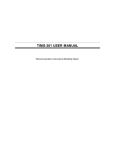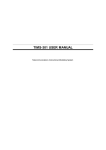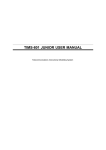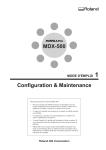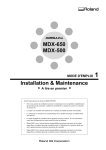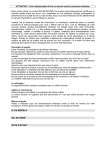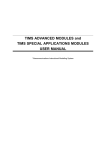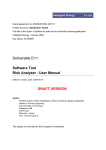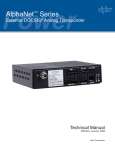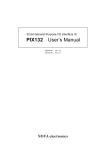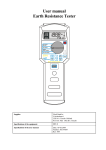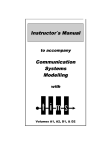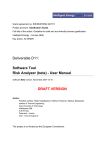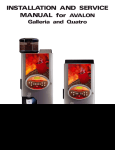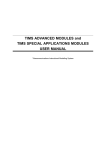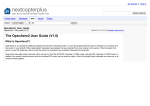Download TIMS-301 USER MANUAL - ECE Undergraduate Laboratory
Transcript
TIMS-301 USER MANUAL Telecommunications Instructional Modelling System TIMS-301 USER MANUAL Author: Alfred Breznik and Carlo Manfredini Issue Number 1.6 October 2004 All specifications are subject to change without notice. Published by: EMONA INSTRUMENTS PTY LTD a.c.n. 001 728 276 86 Parramatta Road Camperdown NSW 2050 Sydney AUSTRALIA web: www.tims.com.au telephone: + 61-2-9519-3933 fax:+ 61-2-9550-1378 Copyright (C) 1988 - 2004 Emona Instruments Pty Ltd and its related entities. All rights reserved. No part of this publication may be reproduced, distributed or translated in any form or by any means, including any network or Web distribution or broadcast for distance learning, or stored in any database or in any network retrieval system, without the prior written constent of Emona Instruments Pty Ltd. For licensing information, please contact Emona Instruments Pty Ltd. The TIMS logo Printed in Australia is a registered trademark of Emona TIMS Pty Ltd. CONTENTS Part I TIMS INTRODUCTION TIMS OVERVIEW SYSTEM CONVENTIONS Front Panel Sockets Plug-in Modules Labelling Basic Modules List Basic Specifications Part II BASIC MODULES USER INSTRUCTIONS Adder Audio Oscillator Buffer Amplifiers Dual Analog Switch Frequency and Event Counter Headphone Amplifier and 3kHz LPF Master Signals Multiplier Phase Shifter Quadrature Phase Splitter Scope Selector Sequence Generator Trunks Panel Tuneable LPF Twin Pulse Generator Utilities Module Variable DC Voltage Controlled Oscillator 60kHz Lowpass Filter 1 2 3 4 5 6 7 8 9 10 12 13 15 16 17 19 20 21 23 25 26 28 TIMS INTRODUCTION TIMS OVERVIEW TIMS is a telecommunications modelling system. It models mathematical equations representing electrical signals, or block diagrams representing telecommunications systems. TIMS is primarily a hands-on rather than demonstration style teaching system, which combines both the theoretical and practical aspects of implementing systems. We are confident that TIMS will provide the student with a clearer understanding of the concepts behind telecommunications theory. Physically, TIMS is a dual rack system. The top rack accepts up to 12 Eurocard sized, compatible "black boxes", or modules. The lower rack houses a number of fixed modules, as well as the system power supply. The modules are very simple electronic circuits, which function as basic communications building blocks. Each module, fixed or plug-in, has a specific function; functions fall into four general categories: Signal Generation - oscillators, etc Signal Processing - multipliers, filters, etc Signal Measurement - frequency counter Digital Signal Processing - TMS320C50 based (DSP & Advanced Modules are not included in the BASIC TIMS-301 SYSTEM) Modules are patched together via the front panel sockets using interconnecting leads, to model the system under investigation. TIMS-301 User Manual 1 SYSTEM CONVENTIONS All TIMS modules conform to the following mechanical and electrical conventions. A - FRONT PANEL SOCKETS Signal interconnections are made via front panel, 4mm sockets Sockets on the LEFT HAND SIDE are for signal INPUTS. All inputs are high impedance, typically 56k ohms. Sockets on the RIGHT HAND SIDE are for signal OUTPUTS. All outputs are low impedance, typically 330 ohms. YELLOW sockets are only for ANALOG signals. ANALOG signals are held near the TIMS standard reference level of 4V pk-pk. RED sockets are only for DIGITAL signals. DIGITAL signals are TTL level, 0 to 5 V. GREEN sockets are all common, or system GROUND. Note that input and output impedances are intentionally mismatched, so that signal connections may be made or broken without changing signal amplitudes at module outputs. B - PLUG-IN MODULES Any plug-in module may be placed in any of the 12 positions of the upper rack. All modules use the back plane bus to obtain power supply : only the DSP modules (not part of the BASIC SYSTEM) use the bus to transfer signals. The modules are designed so that they may be plugged-in or removed at any time, without turning off the system power. The modules are not locked into position and may need to be held while interconnecting leads are removed. C - LABELLING All modules are identified as to the function they perform. Inputs, outputs, controls and switches are labelled so that a student who has had only a brief introduction to TIMS can use the modules without needlessly referring back to this USER MANUAL. It should be noted that no variable controls have calibration marks. This is intentional, as the philosophy behind TIMS is that students setup and adjust systems by observing and measuring signals. This assists the student in gaining a much greater understanding, feel and insight into the operation of a communications implementation. TIMS-301 User Manual 2 D - BASIC MODULE LIST Below are listed all the BASIC SYSTEM MODULES. FIXED modules are located in the lower rack, while PLUG-IN modules can be positioned anywhere in the upper rack. Adder - plug-in Audio Oscillator - plug-in Buffer Amplifiers - fixed Dual Analog Switch - plug-in Frequency and Event Counter - fixed Headphone Amplifier and 3kHz LPF - fixed Master Signals - fixed Multiplier - plug-in Phase Shifter - plug-in Quadrature Phase Splitter - plug-in Scope Display Selector - fixed Sequence Generator - plug-in Trunks Panel - fixed Tuneable LPF - plug-in Twin Pulse Generator - plug-in Utilities Module - plug-in Variable DC - fixed Voltage Controlled Oscillator - plug-in 60kHz Lowpass Filter - plug-in BASIC SPECIFICATIONS POWER SUPPLY Input 120, 127, 220 or 240V AC, 47Hz to 63Hz Output + 15V, 2.2A DC -15V, 2.2A DC Protection short circuit, overload, thermal Regulation 0.2% PHYSICAL Case Dimensions 490(W) x 330(D) x 310(H) mm System Weight 10kg Plug-in Card Dimensions 160 x 100 mm Plug-in Card Bus Connectors 64 way, 2 row, Eurocard MODULES Specifications for each module are listed in the following pages. TIMS-301 User Manual 3 ADDER Two analog input signals A(t) and B(t) may be added together, in adjustable proportions G and g. The resulting sum is presented at the output. G:GAIN CONTROL FOR INPUT A ANALOG INPUT g:GAIN CONTROL FOR INPUT B ANALOG OUTPUT ANALOG INPUT FRONT PANEL BLOCK DIAGRAM USE Care must be taken when adjusting the gains to avoid overloading the following modules. Overloading will not cause any damage but it means non-linear operation, which is to be avoided in analog systems. The ADDER is capable of delivering a signal well in excess of the standard reference level, 4V pk-pk, given a standard level input. The ADDER can also be used as a normal amplifier by using only one input and turning the gain of the other input to minimum. It is not necessary to ground the unused input. Note that gains G and g are negative. All inputs and outputs are DC coupled. BASIC SPECIFICATIONS Gain Range 0 < G < 2; 0 < g < 2; Bandwidth approx 1MHz Output DC Offset < 10mV, open circuit inputs PARAMETERS TO NOTE maximum output level; linearity; polarity inverting; phase shift TIMS-301 User Manual 4 AUDIO OSCILLATOR The AUDIO OSCILLATOR is a low distortion tuneable frequency sinewave source with a frequency range from 500Hz to 10kHz. Three outputs are provided. Two outputs are sinusoidal, with their signals in quadrature. The third output is a digital TTL level signal. INPHASE ANALOG OUTPUT SYNCHRONIZE INPUT FREQUENCY ADJUST TTL LEVEL OUTPUT QUADRATURE ANALOG OUTPUT FRONT PANEL BLOCK DIAGRAM USE The frequency of each of the three outputs is the same and is varied by the front panel ∆ f control. Both the in-phase and quadrature analog output signals have fixed amplitude. Their shape is sinusoidal, having a distortion of less than 0.1%. The AUDIO OSCILLATOR may be synchronized to an external periodic signal by connecting such a signal to the front panel SYNC input. A signal of about 1 volt peak is adequate for this purpose. For synchronization to be achieved, the AUDIO OSCILLATOR must be manually tuned to within a few percent of the frequency to which synchronization is desired. BASIC SPECIFICATIONS Frequency Range 300Hz to 10kHz Analog Output Level 4V pk-pk Distortion < 0.1% analog outputs only Digital Output TTL level PARAMETERS TO NOTE frequency range; relative phase of outputs; amplitude stability with frequency range; harmonic content; short term stability; synchronizing characteristic. TIMS-301 User Manual 5 BUFFER AMPLIFIERS Two independent variable gain amplifiers are provided. GAIN CONTROL ANALOG INPUT OF FIRST AMPLIFIER ANALOG OUTPUT GAIN CONTROL ANALOG INPUT OF SECOND AMPLIFIER ANALOG OUTPUT FRONT PANEL BLOCK DIAGRAM USE These buffers may be used to amplify small signals or attenuate large signals. Each amplifier has its own gain control on the front panel. Care should be taken to ensure that later modules are not overloaded due to excessive gain. Overload will not cause any damage but it means non-linear operation, which is to be avoided in analog systems. If overload occurs, turn the gain control counter clockwise. BASIC SPECIFICATIONS Bandwidth DC to approx 1MHz Gain 0 to 10 TIMS-301 User Manual 6 DUAL ANALOG SWITCH Two identical analog switches are controlled by digital, TTL level signals. The outputs of the two switches are added internally and presented at the output of the module. ANALOG INPUT 1 TTL CONTROL FOR INPUT 1 TTL CONTROL FOR INPUT 2 ANALOG INPUT 2 OUTPUT FRONT PANEL BLOCK DIAGRAM USE Each switch may be closed independently by a TTL HIGH at the respective control input. The switch outputs are combined internally and are presented at the common output socket. Open circuit voltage gain between each input and the module output is unity when the switch is closed. BASIC SPECIFICATIONS Analog Input Bandwidth > 300kHz Maximum CONTROL clock > 100kHz CONTROL Input Levels TTL only Maximum Analog Input Level + 8V PARAMETERS TO NOTE switch On/Off ratio; linearity; switching speed; analog bandwidth; channel cross talk; DC off-set TIMS-301 User Manual 7 FREQUENCY COUNTER The TIMS counter is an 8 digit, 10MHz frequency and event counter. 9 8 7 1 2 6 3 4 5 BASIC SPECIFICATIONS 1 OVERflow indication LED 2 ANALOG input: Bandwidth 40Hz to 1 MHz Sensitivity 250mV typically, @ 100kHz Maximum input + 12V 3 TTL Input: Bandwidth DC to 10MHz Input TTL level signals only 4 TTL ENABLE may be used to gate the TTL input signal. Specifications are same as for the TTL input. 5 Mode and Range rotary switch Frequency counter mode Gate time selection of 0.1s, 1s or 10s with reading in kHz Event counter mode displays number of pulses counted since the last RESET 6 RESET Push Button resets the count of the Event Counter to zero 7 kHz LED is lit when counter is in FREQUENCY COUNTER mode 8 8 digit, 7 segment display of frequency or pulse counts; maximum display 99999999 9 COUNTS LED is lit when counter is in EVENT COUNTER mode TIMS-301 User Manual 8 HEADPHONE AMPLIFIER and 3kHz LPF The HEADPHONE AMPLIFIER is a wideband, variable gain audio amplifier which will drive standard 8ohm headphones or a speaker. An independent 3kHz LOWPASS FILTER may be switched in before the audio amplifier, if required. FOR SWITCHING LPF OUTPUT TO AMPLIFIER INPUT LOWPASS FILTER OUTPUT AMPLIFIER GAIN ADJUST AMPLIFIER AND FILTER INPUT HEADPHONE OUTPUT FRONT PANEL BLOCK DIAGRAM USE This module serves as an electro-acoustic interface between the audio signals within the system and the user. Included within the HEADPHONE AMPLIFIER module is an independent LOWPASS FILTER with a 5th order elliptic characteristic. The filter’s cutoff frequency is 3kHz, stopband attenuation is 50dB and passband ripple is 0.2dB. BASIC SPECIFICATIONS AUDIO AMPLIFIER Bandwidth < 100kHz THD 0.2% (RL= 8ohms, P= 125mW) Maximum Gain 20 Maximum Output Power 500mW Output Impedance 8 ohms LOWPASS FILTER Cutoff Frequency 3kHz Stopband Attenuation 50dB Passband Gain approx 1 Passband Ripple 0.2dB PARAMETERS TO NOTE filter corner point; filter shape; passband ripple; out-of- band attenuation; amplifier distortion TIMS-301 User Manual 9 MASTER SIGNALS Five synchronized analog and digital signals are available, ranging from 2kHz to 100kHz. The function and frequency of each signal is indicated on the front panel. QUADRATURE ANALOG CARRIER SIGNAL INPHASE ANALOG CARRIER SIGNAL TTL LEVEL CARRIER SIGNAL TTL LEVEL ANALOG SIGNAL FRONT PANEL BLOCK DIAGRAM USE Signals are labelled as follows: CARRIER signals are 100kHz, which for modelling purposes is sufficiently far from the audio channel bandwidth of 3kHz. The SAMPLE CLOCK of 8.3kHz, which may be used to sample bandwidth-limited (3kHz) audio message signals. MESSAGE provides an audio frequency signal which is synchronized to a sub-multiple of the carrier to enable ’text-book’ like displays of simple modulation schemes to be achieved. The five signals are derived from a master crystal oscillator resulting in low frequency drift. Their frequencies are fixed internally. The output levels are also fixed. To vary the amplitude, the signals may be applied to the neighboring buffers. The analog signals are sinusoidal in shape, having a distortion of less than 0.1%. Digital signals are all standard TTL level, with rise times of better than 80nsec. TIMS-301 User Manual 10 BASIC SPECIFICATIONS Output Frequencies 100kHz, carrier 8.333kHz, sample clock 2.083kHz, audio (carrier sub-multiple) Output Levels 4V pk-pk, analog TTL level, digital Distortion < 0.1%, analog outputs only PARAMETERS TO NOTE short term frequency stability; relative phase of quadrature outputs; harmonic content. TIMS-301 User Manual 11 MULTIPLIER Two analog input signals X(t) and Y(t) may be multiplied together. The resulting product is scaled by a factor of approximately 1/2 so that, with standard level inputs, later stages are not overloaded. INPUT COUPLING SWITCH ANALOG INPUT ANALOG OUTPUT ANALOG INPUT FRONT PANEL BLOCK DIAGRAM USE The input coupling switch may be used to remove input DC components by switching to AC coupling. It should be noted that any DC component in the output will not be removed. The "k" factor (a scaling parameter associated with "four quadrant" multipliers) is approximately one half. It is defined with respect to the OUTPUT from the module and may be measured experimentally. BASIC SPECIFICATIONS Bandwidth approx 1MHz Characteristic k.X(t).Y(t) k approx 1/2 PARAMETERS TO NOTE linearity; k factor; carrier leak; phase response; DC off-set; performance as a squarer; frequency response; "conversion gain" as a (de)modulator. TIMS-301 User Manual 12 PHASE SHIFTER The PHASE SHIFTER introduces a phase shift between its input and output. This phase shift is adjustable by the user. The frequency range of operation can be selected by PCB mounted switch. BLOCK DIAGRAM COARSE PHASE ADJUST FINE PHASE ADJUST 180O PHASE CHANGE ANALOG OUTPUT ANALOG INPUT FRONT PANEL PCB VIEW USE This variable PHASE SHIFTER is capable of varying the magnitude of the phase shift through 360 degrees in two steps. The 180 degree switch selects the step or region of interest; the COARSE and FINE controls are used to then obtain the required phase shift, Φ. If the input is COS(µt), then the output is COS(µt- Φ), where Φ lies between 0 and 180 degrees. Although the PHASE SHIFTER will operate from a few hertz up to 1MHz it has been optimized to operate in the neighborhood of two frequencies: around 100kHz in the HI range and around 2kHz in the LO range. A PCB mounted switch is used to select the frequency range. The open circuit gain through the PHASE SHIFTER is essentially unity for all phases, but note that the amount of phase shift, Φ, is a function of frequency. This is NOT a wideband phase changer: thus all the frequency components of a complex signal’s spectra are not shifted by the same phase. TIMS-301 User Manual 13 BASIC SPECIFICATIONS Bandwidth < 1MHz Frequency Range HI approx 100kHz * LO approx 2kHz * * For 0 to 360 degree range of phase shift. The phase shift range increases (i.e. resolution decreases) as the input frequency increases. Coarse approx 180 degrees shift Fine approx 20 degrees shift PARAMETERS TO NOTE Variation of phase change with frequency change. TIMS-301 User Manual 14 QUADRATURE PHASE SPLITTER When the same analog signal is applied to both inputs, the two output signals will differ in phase by 90 degrees. The phase splitter networks are wideband, typically covering the range from 200Hz to 10kHz. ANALOG INPUT TO NETWORK 1 ANALOG OUTPUT FROM NETWORK 1 ANALOG INPUT TO NETWORK 2 ANALOG OUTPUT FROM NETWORK 2 FRONT PANEL BLOCK DIAGRAM USE The QUADRATURE PHASE SPLITTER consists of two wideband phase shifting networks. The networks’ phase responses vary with frequency in a complimentary manner, giving a 90 degree phase difference between the outputs, over a wide frequency range. In communications the most important application is the generation and demodulation of Single Sideband by the "phasing method". BASIC SPECIFICATIONS Frequency Range 200Hz to 10kHz typically Phase Response 90 degrees between outputs, given the same input signal to both networks. PARAMETERS TO NOTE Phase error from 90 degrees. This may be measured directly (difficult !) or calculated from sideband suppression measurements. TIMS-301 User Manual 15 SCOPE SELECTOR (OSCILLOSCOPE DISPLAY SELECTOR) The OSCILLOSCOPE DISPLAY SELECTOR allows 2 of 4 different signals to be viewed simultaneously on a 2 channel oscilloscope. A third input labeled TRIG is ideal for connecting a trigger signal to the oscilloscope’s external trigger input. INPUT SELECTOR CH1 INPUT "A" CH1 OUTPUT CH1 INPUT "B" CONNECT TO SCOPE TRIGGER INPUT TRIGGER INPUT INPUT SELECTOR CH2 INPUT "A" CH2 OUTPUT CH2 INPUT "B" FRONT PANEL DIAGRAM USE Connection to the oscilloscope is via BNC sockets. Inputs are standard 4mm sockets. Although the input sockets are YELLOW (analog), either analog or digital signals may be examined. TIMS-301 User Manual 16 SEQUENCE GENERATOR (PSEUDORANDOM SEQUENCE GENERATOR) Using a common external clock signal, the sequence generator outputs two independent pseudorandom sequences X and Y. A SYNC output is provided which is coincident with the start of the sequences. The sequences may be stopped and restarted at any time via front panel controls. Sequences X and Y are available as either standard TTL or analog level output. RESET PUSH BUTTON ANALOG OUTPUT TTL LEVEL RESET ANALOG OUTPUT BEGINNING OF SEQUENCE SYNCH ANALOG CLOCK TTL OUTPUT TTL CLOCK TTL OUTPUT FRONT PANEL BLOCK DIAGRAM USE An external clock signal must be provided to operate the SEQUENCE GENERATOR. This may be sinusoidal or TTL: separate input sockets are used. The sequences may be stopped at any time by either depressing the RESET button or applying a TTL HI signal to the RESET input. To restart the sequences from the beginning, release the RESET button or apply a TTL LO to the RESET input. The length of the sequences may be selected by a PCB mounted dip switch. Four independent sequence pairs are available from lengths of 25 to 211. The sequences are selected as follows: DIP SWITCH CODE n SEQUENCE LENGTH 2n msb 0 0 5 32 0 1 8 256 1 0 8 256 1 1 11 2048 TIMS-301 User Manual 17 BASIC SPECIFICATIONS Input Clock Range TTL 1Hz to 1MHz Analog < 500Hz to > 10kHz Number of Sequences 4 pairs Sequence Lengths 25, 28, 28, 211 Sync indicates start of sequence PARAMETERS TO NOTE sequence distribution; noise generation using pseudorandom sequences. TIMS-301 User Manual 18 TRUNKS PANEL The TRUNKS PANEL provides inputs and outputs to signals which are transmitted along the OPTIONAL TIMS BUS classroom network. The three outputs SIGNAL 1, SIGNAL 2 and SIGNAL 3 present signals from the lecturer’s master system. IN and OUT allow for signals to be respectively received from and transmitted to a neighboring TIMS system. SIGNALS 1, 2 & 3 COME FROM THE MASTER TIMS SYSTEM IF TRUNKS IS CONNECTED INCOMING SIGNAL FROM ADJACENT STUDENT’S TIMS SYSTEM, IF TRUNKS IS CONNECTED OUT SENDS A SIGNAL TO THE NEXT STUDENT’S TIMS SYSTEM, IF TRUNKS IS CONNECTED FRONT PANEL USE Note that the TRUNKS PANEL is a module that differs from the TIMS’ front panel color code and alignment conventions. Though the inputs and outputs are YELLOW (analog), either analog or digital signals may be used. Also, the signal input, OUT, which accepts a signal that is to be transmitted to a neighboring TIMS system, is on the right hand side. BASIC SPECIFICATIONS when TIMS-TRUNKS is installed Master Channels 3 : SIGNAL 1, SIGNAL 2 and SIGNAL 3; Master Channel Bandwidth 700kHz (typ), ac coupled. Local Channels 2 : IN brings the incoming signal FROM an adjacent TIMS’ OUT port. OUT carries the outgoing signal TO the other adjacent TIMS’ IN port. Local Channel Bandwidth 350kHz (typ), ac coupled TIMS-301 User Manual 19 TUNEABLE LPF The cutoff frequency of this LOWPASS FILTER can be varied using the TUNE control. Two frequency ranges, WIDE and NORMAL, can be selected by a front panel switch. The GAIN control allows signal amplitudes to be varied if required. CLK for TLPF modules V1 to V3: CLK/880 = f-3dB; NORMAL CLK/360 = f-3dB; WIDE CLK for TLPF modules V4: CLK/100 = f-3dB; NORMAL & WIDE CUT-OFF FREQUENCY ADJUST GAIN ADJUST FREQUENCY RANGE SELECT ANALOG OUTPUT ANALOG INPUT BLOCK DIAGRAM USE FRONT PANEL This lowpass filter has an elliptic filter characteristic. The stopband attenuation is typically 50dB and passband ripple is approximately 0.5dB. The GAIN control is used to vary the amplitude of the output signal. Care should be taken to avoid overloading/saturation. Two frequency ranges are provided. NORMAL range provides more precise control over the lower audio band, used for telecommunications message channels. The WIDE range expands the filter’s range to above 10kHz. The CLK output provides an indication of the filter’s cutoff frequency. BASIC SPECIFICATIONS for TLPF modules V1 to V3 Filter Ranges 900 Hz < NORMAL < 5 kHz and 2.0 kHz < WIDE < 12 kHz, continuously variable over each range. Filter Order 7th order, Elliptic Stopband Attenuation > 50dB and Passband Ripple < 0.5dB BASIC SPECIFICATIONS for TLPF modules V4 Filter Ranges 200 Hz < NORMAL < 5 kHz and 200 Hz < WIDE < 12 kHz, continuously variable over each range. Filter Order 5th order, Elliptic Stopband Attenuation > 50dB and Passband Ripple < 0.5dB Maximum Input Voltage + 5V to -5V (TTL-level input signal is acceptable) PARAMETERS TO NOTE corner point; phase shift; gain range; passband ripple; out of band attenuation. TIMS-301 User Manual 20 TWIN PULSE GENERATOR (TWIN PULSE GENERATOR - VERSION 2.0) A positive going edge applied at the CLOCK input causes a positive pulse to occur at the output terminals. There are two operating modes: TWIN and SINGLE. Only TWIN mode is limited to low frequency CLOCK inputs. In TWIN mode, Q1 outputs the leading pulse and Q2 outputs the delayed pulse. The time between pulses Q1 and Q2 can be varied, as can the pulses’ widths. In SINGLE mode, only Q1 outputs a positive going pulse, while Q2 outputs the inverse of Q1. The pulse width can be varied. ERROR LED, INDICATES IF 2tW + tD > tCLK BLOCK DIAGRAM PULSE WIDTH CONTROL DELAYED PULSE OUTPUT: TTL LEVEL LEADING PULSE OUTPUT: AC COUPLED DELAY TIME CONTROL DIGITAL CLOCK TTL LEVEL OUT FRONT PANEL TIMING DIAGRAM USE A digital TTL level signal is applied to the CLK input. The GENERATOR then outputs one or two pulses, depending upon the operating mode selected. Use the PCB mounted MODE switch to select either SINGLE or TWIN operating mode. TWIN MODE TWIN mode is used when two sequential pulses are needed. Two equal width positive pulses occur as a result of each CLK signal positive edge. Pulse Q1 always occurs before pulse Q2. The width of both pulses is controlled by the front panel WIDTH control. The DELAY control varies the spacing between the two pulses. Note that TWIN mode will only accept CLOCK input signals of up to 50kHz, depending upon front panel settings. If WIDTH and DELAY have been incorrectly set, causing anomalous operation, the ERROR LED will be lit. To eliminate the error reduce DELAY and then WIDTH - by turning counter clockwise. TIMS-301 User Manual 21 SINGLE MODE SINGLE mode is used to obtain a train of equal width pulses from any TTL level signal. Equal width positive pulses occur at Q1 output as a result of each CLK signal positive edge. The width of the pulses is controlled by the front panel WIDTH control. Q2 simultaneously outputs the compliment of Q1. The DELAY control is not used in this mode. Note that Q1 includes both a TTL level and an AC coupled output pulse. BASIC SPECIFICATIONS TWIN MODE Clock Frequency Range < 50kHz Pulse WIDTH 3µs < tw < 25µs Pulse DELAY Q2-Q1 10µs < td < 120µs Error Indication 2tw + td > tCLK SINGLE MODE Clock Frequency Range < 200kHz Pulse WIDTH 3µs < tw < 25µs TIMS-301 User Manual 22 UTILITIES MODULE The Utilities Module houses 4 independent functional blocks: (i) A signal COMPARATOR with TTL output and CLIPPER with bipolar output, for squaring analog waveforms. The COMPARATOR’s threshold level may be set as required by applying a DC voltage to the REF input. The CLIPPER’s gain may be set by adjusting DIP switches SW1 and SW2. (ii) Precision halfwave RECTIFIER. (iii) Simple diode and single pole, audio range, RC Lowpass Filter. (iv) Single pole, audio range, RC Lowpass Filter. CLIPPER BIPOLAR OUTPUT ANALOG REFERENCE INPUT ANALOG SIGNAL INPUT COMPARATOR TTL OUTPUT ANALOG INPUT ANALOG OUTPUT ANALOG INPUT ANALOG OUTPUT ANALOG INPUT ANALOG OUTPUT FRONT PANEL BLOCK DIAGRAM USE COMPARATOR The COMPARATOR will square any analog signal and provide a standard TTL level output. The switching threshold level is determined by the voltage level applied to the REF input. NOTE: For correct COMPARATOR operation, the REF input must never be left unconnected. The REF input may be connected to GROUND, VARIABLE DC or any other signal source. CLIPPER The CLIPPER will amplify any analog TIMS level signal and then clip the amplitude of the amplified signal, to a fixed level of approximately + 1.8V. The clipping action is performed by standard small signal diodes. NOTE: The REF input is NOT used by the CLIPPER. TIMS-301 User Manual 23 Adjusting the gain of the CLIPPER, determines whether the clipping action is "SOFT", "MEDIUM" or "HARD". The following table, UTIL-1, relates DIP switch settings to CLIPPER gains and clipping action, CLIPPING GAIN DIP SWITCH SETTINGS ACTION (approx) SW1 (both a & b) SW2 (both a & b) SOFT x0.8 ON - ON OFF - OFF MEDIUM x8 OFF - OFF OFF - OFF HARD x40 OFF - OFF ON - ON - not applicable ON - ON ON - ON Table UTIL-1: CLIPPER gain settings DIP switches SW1 and SW2 will be found in the middle of the UTILITIES module’s circuit board. NOTE: Both halves (bits) of each switch must be in the SAME position at all times. BASIC SPECIFICATIONS COMPARATOR Operating Range > 500kHz TTL Output Risetime 100nsec (typ) CLIPPER Operating Range > 500kHz Output Level 1.8Vpk (typ) Adjustable Gains 3 steps; x0.8, x8 and x40 (approx) RECTIFIER Bandwidth DC to 500kHz (approx) DIODE & LPF LPF -3dB 2.8kHz (approx) RC LPF LPF -3dB 2.8kHz (approx) TIMS-301 User Manual 24 VARIABLE DC The VARIABLE DC module is a stable, bipolar DC source. + 5V DC VOLTAGE CONTROL DC OUTPUT GROUND REFERENCE FRONT PANEL BLOCK DIAGRAM USE The DC voltage output varies from about -2.5V when the control is fully counter clockwise through zero to + 2.5V when control is turned fully clockwise. If greater resolution or wider range is required, then one of the BUFFER AMPLIFIERS can be used in conjunction with the VARIABLE DC module. BASIC SPECIFICATIONS Voltage Range + 2.5V DC Short-term Stability < 2mV/hr Resolution approx 20mV Output Current < 5mA TIMS-301 User Manual 25 VCO The Voltage Controlled Oscillator module functions in two modes: either as a VOLTAGE CONTROLLED OSCILLATOR with analog input voltage or as an FSK GENERATOR with digital input. Both modes have two frequency ranges of operation which are selected by a range switch. The VCO frequency and input sensitivity can be controlled from the front panel. FSK DATA INPUT - TTL LEVEL TTL LEVEL OUTPUT SET SENSITIVITY OF INPUT CONTROL VOLTAGE Vin OVERLOAD INDICATION LED SET CENTER FREQUENCY BLOCK DIAGRAM FREQUENCY RANGE SELECTION CONTROL VOLTAGE INPUT ANALOG OUTPUT FRONT PANEL PCB VIEW VCO USE STANDARD VCO OPERATION The VCO output frequency is controlled by an analog input voltage. The input voltage, Vin, is scaled - amplified - by the front panel GAIN control. A DC voltage can be added to Vin internally, thus setting the start or CENTER FREQUENCY, fo . The CENTER FREQUENCY is defined as the VCO output frequency, when no voltage is applied to the Vin connector. The Vin input is internally tied to ground if no signal is applied. The Vin OVERLOAD LED is lit when the sum of these voltages - scaled Vin plus CENTER FREQUENCY DC offset - exceed the oscillator’s internal operating limits. Decrease the GAIN - turn counter clockwise - and/or shift the CENTER FREQUENCY, fo , to extinguish the LED. The frequency range switch selects between the HI or carrier band and the LO or audio band. Both sinewave and digital outputs are available. TIMS-301 User Manual 26 SPECIAL VCO OPERATION - FINE FREQUENCY CONTROL In some applications, fine control may be required over the output frequency of the VCO. This may be easily achieved by following these four steps: MODULES REQUIRED: VCO and VARIABLE DC. STEP 1 - Set the VARIABLE DC module’s output close to zero (marker knob at 12 o’clock position). STEP 2.1 - Turn the GAIN control of the VCO to zero, fully counter-clockwise. STEP 2.2 - Now, turn the GAIN control up, clockwise, just a little (only a few degrees). STEP 3 - Set the VCO module’s output frequency as close as possible to the frequency of interest. Use the frequency adjust knob, fo. Use the FREQUENCY COUNTER to measure the VCO’s output frequency. STEP 4 - Finally, patch the VARIABLE DC module’s output to the VCO module’s frequency control input, Vin, with a standard patching lead. FINE FREQUENCY CONTROL of the VCO module is now achieved by turning the VARIABLE DC module’s voltage control knob. FSK USE A PCB mounted slide switch selects between FSK and VCO modes of operation. The two output frequencies, FSK1 and FSK2 , (MARK and SPACE), are set by varying the PCB mounted, finger adjustable trimmers. As in VCO mode, the frequency range switch selects between the HI or carrier band and the LO or audio band. The digital data input accepts only TTL level signals. Both sinewave and digital outputs are available. GAIN and CENTER FREQ, fo , controls and the Vin connector are not used in the FSK mode. BASIC SPECIFICATIONS VCO MODE Frequency Ranges 1.5kHz < LO < 17kHz; sinewave and TTL ( < 300Hz with external input voltage, Vin ) 70kHz < HI < 130kHz; sinewave and TTL Input Voltage -3V < Vin < 3V Overload limit indication LED Vvco > + 3V; Vvco is the internal voltage finally applied to the VCO circuitry. GAIN G.Vin : 1 < G < 2 Center Frequency Voltage Range - 3V < Vfc < 3V; Vfc is a DC voltage added INTERNALLY to G.Vin FSK MODE Frequency Ranges 1.5kHz < FSK1, LO < 9kHz 500Hz < FSK2, LO < 4kHz 80kHz < FSK1, HI < 200kHz 20kHz < FSK2, HI < 120kHz Data Input TTL level message TIMS-301 User Manual 27 60kHz LOWPASS FILTER An elliptic lowpass filter is provided with a cutoff point of approximately 60kHz. The input signal amplitude can be adjusted with the gain control. ANALOG OUTPUT ANALOG INPUT FRONT PANEL BLOCK DIAGRAM USE The 60kHz LPF allows carrier signals to be removed from a given signal spectrum. For example, as the lowpass filter for envelope detector applications. The GAIN control allows input signals to be attenuated, to avoid overloading the filter. BASIC SPECIFICATIONS Cutoff Frequency approx 60kHz Passband Gain variable, 0 to 5 (approx) Stopband Attenuation 50dB (typ) Passband Ripple 0.1dB (typ) PARAMETERS TO NOTE corner point; response shape; passband ripple; phase shift; out of band attenuation. TIMS-301 User Manual 28 TIMS-301/C Safety Information The Emona TIMS-301/C User Manual contains important information and warnings which have to be followed by the user to ensure safe operation. The TIMS-301/C System is Safety Class I laboratory equipment and is designed to meet the requirements of EN61010-1. The Installation Category is Category II, intended for operation from a normal single phase supply. The TIMS-301/C System has been designed for indoor use in a Pollution Degree I environment (no pollution, or only dry non-conductive pollution) in the temperature range of 5 degrees C to 40 degrees C, 20% to 80% RH (non-condensing). It may occasionally be subjected to temperature between +5 degrees and -10 degrees without degradation of its safety. WARNING! TIMS EQUIPMENT MUST BE EARTHED Any interruption of the mains earth conductor inside or outside the equipment will make the equipment dangerous. Intentional interruption is prohibited. Make sure that only fuses with the required rated current and of the specified type are used for replacement. Use of this equipment in a manner not specified by these instructions may impair the safety protection provided. Do not operate the equipment outside its rated supply voltages or environmental range. In particular, excessive moisture may impair safety. Front Panel Connections - INPUT SOCKETS, RED WARNING! DO NOT APPLY EXTERNAL VOLTAGES EXCEEDING +5.5V or -0.5V and FREQUENCIES EXCEEDING 1MHz. - INPUT SOCKETS, YELLOW WARNING! DO NOT APPLY EXTERNAL VOLTAGES EXCEEDING +/-15V and FREQUENCIES EXCEEDING 200kHz. - OUTPUT SOCKETS, RED and YELLOW WARNING! DO NOT APPLY EXTERNAL VOLATGES TO ANY OUTPUT SOCKET Safety Terms and Symbols WARNING. Warning of potential hazard O I mains supply OFF mains supply ON Installation Check the operating voltage marked on the rear panel is suitable for the local supply. Should it be necessary to change the operating voltage, please contact your supplier or Emona Instruments Pty Ltd. FUSE Ensure that the correct mains fuse is fitted for the set operating voltage, as follows: for 220 or 240V operation: for 110V or 127V operation 630mA (T) 250 V 1.2A (T) 250V MAINS LEAD Ensure an approved type IEC mains lead with earth connection is used. WARNING! TIMS EQUIPMENT MUST BE EARTHED Any interruption of the mains earth conductor inside or outside the equipment will make the equipment dangerous. Intentional interruption is prohibited. MOUNTING The equipment is designed for bench use. Sicherheitsanweisung für das System TIMS-301/C Die Gebrauchsanweisung des Systems TIMS-301/C beinhaltet wichtige Informationen und Sicherheitswarnungen, die vom Benutzer beachtet werden müssen. Dieses System ist ein Laborgerät der Sicherheitsklasse 1, das der Norm EN 61010-1 und der Kategorie 2 entspricht und für einphasigen Strom vorgesehen ist. Es ist nur für den Betrieb in Innenräumen zulässig, in einer Umgebung des Verschmutzungsgrades 1 ( keine Verschmutzung oder trockene, nichtleitende Verschmutzung ), bei Temperaturen zwischen 5 und 40°Celsius und 20-80% relativer Luft feuchtigkeit (ohne Kondensation). Achtung! Das TIMS System muss geerdet werden Jedes Abtrennen der Masseleitung im Inneren oder Äußeren des Systems ist lebensgefährlich. Der Schutzleiter darf auf keinen Fall unterbrochen werden. Benutzen Sie ausschließlich Sicherungen, deren Nennstrom und Typ den spezifizierten Werten entsprechen. Jeder Gebrauch dieses Apparats unter Bedingungen, die in dieser Gebrauchsanweisung nicht festgesetzt sind, kann die Sicherheit beeinträchtigen. Benutzen Sie den Apparat keinesfalls außerhalb der spezifizierten Versorgungsspannung oder der beschriebenen atmosphärischen Bedingungen. Ein Übermaß an Feuchtigkeit vermindert die Sicherheit. Frontplattenanschlüsse ROTE EINGÄNGE Achtung! Keine externe Spannung > +5,5 V / < -0,5 V oder Signale anschließen. > 1 MHz GELBE EINGÄNGE Achtung! Keine externe Spannung die +/-15 V übersteigt oder Signale mit einer Frequenz > 200 MHz anschließen ROTE UND GELBE AUSGÄNGE Achtung! Keine Signale an die Ausgänge anlegen Sicherheitssymbole und Sicherheitsbegriffe ACHTUNG. Warnung bezüglich eines Gefahrenpotentials O Stromversorgung ausgeschaltet I Stromversorgung eingeschaltet Installierung Stellen Sie sicher, dass die Betriebsspannung, die auf der Rückwand angegeben ist, Ihrer Stromversorgung entspricht. Um die Betriebsspannung zu verändern, kontaktieren Sie Ihren Lieferanten oder Emona Instruments Pty Ltd. SICHERUNG Stellen Sie sicher, dass Sie eine Sicherung benutzen, die Ihrer Betriebsspannung entspricht: Für einen Gebrauch von 220 oder 240 V: 630 mA (T) 250 V Für einen Gebrauch von 110 oder 127 V: 1,2 A (T) 250 V VERSORGUNGSKABEL Benutzen nur Netzkabel mit einem Schutzleiter. Consignes de sécurité concernant le système TIMS-301/C Le manuel utilisateur du système TIMS-301/C comprend d’importantes informations et mises en garde de sécurité devant être prises en compte par l’utilisateur. Ce système est un appareil de laboratoire de classe de sécurité 1 conforme à la norme EN61010-1 et de catégorie d’installation 2, prévu pour fonctionner sous courant monophasé. Il a été conçu pour être utilisé en intérieur, dans un environnement de degré de pollution 1 (pas de pollution ou pollution sèche non conductrice) sous des températures variant entre 5 et 40 ºC, avec 20 à 80 % d’humidité relative (sans condensation). Il peut occasionnellement être utilisé à des températures entre 5 et -10 ºC. ATTENTION ! LE SYSTÈME TIMS DOIT ÊTRE MIS À LA TERRE Toute déconnexion du fil de masse à l'intérieur ou à l'extérieur du système rendra son utilisation dangereuse. Ce fil ne doit en aucun cas être déconnecté. N’utilisez que des fusibles dont le courant nominal et le type correspondent aux valeurs spécifiées. Toute utilisation de cet appareil dans des conditions non stipulées dans le manuel est susceptible d’endommager les dispositifs de sécurité. N’utilisez pas l’appareil hors des tensions d’alimentation ou des conditions atmosphériques prescrites. Un excès d’humidité peut notamment nuire à la sécurité du système. Connexions du panneau avant - ENTRÉES, ROUGES ATTENTION ! NE PAS APPLIQUER DE TENSIONS EXTÉRIEURES SUPÉRIEURES À +5,5 V OU INFÉRIEURES À -0,5 V ni de FRÉQUENCES SUPÉRIEURES À 1 MHz. - ENTRÉES, JAUNES ATTENTION ! NE PAS APPLIQUER DE TENSIONS EXTÉRIEURES DÉPASSANT +/-15 V ni de FRÉQUENCES SUPÉRIEURES À200 MHz - SORTIES, ROUGES et JAUNES ATTENTION ! NE PAS APPLIQUER DE TENSIONS EXTÉRIEURES AUX SORTIES Termes et symboles de sécurité ATTENTION. Avertissement concernant un danger potentiel O I alimentation secteur désactivée alimentation secteur activée Installation Vérifier que la tension de fonctionnement stipulée sur le panneau arrière correspond à votre tension d’alimentation. Pour changer la tension de fonctionnement, veuillez contacter votre fournisseur ou Emona Instruments Pty Ltd. FUSIBLE Vérifiez que vous utilisez le fusible d’alimentation correspondant à votre tension de fonctionnement : pour une utilisation en 220 ou 240 V : pour une utilisation en 110 ou 127 V : 630 mA (T) 250 V 1,2 A (T) 250 V CÂBLE D’ALIMENTATION Utilisez un câble d’alimentation avec prise de terre approuvé par la CEI. ATTENTION ! LE SYSTÈME TIMS DOIT ÊTRE MIS À LA TERRE Toute déconnexion du fil de masse à l'intérieur ou à l'extérieur du système rendra son utilisation dangereuse. Ce fil ne doit en aucun cas être déconnecté. MONTAGE Cet appareil est conçu pour une utilisation en laboratoire. EC Declaration of Conformity for the Emona TIMS series of Telecommunications Teaching Equipment – Modular electronic building-blocks of open architecture intended to be used exclusively for the purposes of experimentation, learning and practical training to investigate the phenomena of modulation, coding and signal transmission in telecommunications. Manufactured by: Emona Instruments Pty Ltd 86 Parramatta Road, Camperdown NSW AUSTRALIA Statement of Conformity: Based on test results using appropriate standards, the product is in conformity with Low Voltage Directive 73/23/EEC. “The use of the apparatus outside the classroom, laboratory, study area or similar such place invalidates conformity with the protection requirements of the Electromagnetic Compatibility Directive (89/336/EEC) and could lead to prosecution. The equipment when operated does not cause electromagnetic disturbance to apparatus situated outside its immediate electromagnetic environment.” Standard used: EN 61010-1 (1993) Safety Requirements for Electrical Equipment for Measurement, Control, and Laboratory Use. The tests have been performed in a typical configuration. This Conformity is indicated by the Alfred Breznik Technical Director symbol.






































